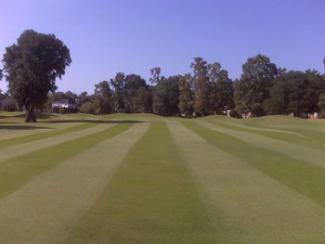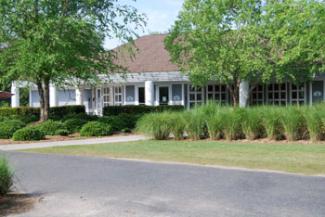Featured Golf News
Crowfield Golf & Country Club is One Tough Beauty
If you're in South Carolina's Lowcountry near Charleston, you've simply got to stop by and play a round at Crowfield Golf & Country Club in Goose Creek.

A Tree-Lined Hole at Crowfield GC
Director of golf operations Troy Sanders invited me and a golf buddy for a tour of the track and we're glad we took him up on the offer. The course, located on the site of the former Crowfield Plantation and Garden (ruins of which are visible near one of the greens), is a rather atypical Lowcountry course in that it has some elevation changes and mounded fairways, leaving you with occasional uneven lies.
Bob Spence and Tom Jackson co-designed the course and did a superb job working the rather narrow routing through some lovely property, which contains hardwoods lining many holes. Keep it straight and you'll enjoy the layout without losing too many balls.
The track plays to a yardage of around 7,000 from the tips and doglegs add to that distance. The course has a Slope of 141 and a rating of 74.2 from the back markers, which gives you an indication of its difficulty, especially if you can't keep your tee shots in the short stuff. There are bunkers - although they're not too numerous - in both fairways and around the greens, which are mid-sized and somewhat undulating. Several of the putting surfaces bear slopes that help trickle a ball to the hole, providing your approach shot finds the proper section.
Water enters play on over half the holes at Crowfield Golf & Country Club, and you've got to deal with it at the strong par-4 opener, a 396-yard dogleg-right. It's tempting to hit driver off the tee and cut off some of the yardage, but the tee ball must by accurate and avoid a wetland that sits below and to the right of the landing area. The first hole also features one of the most dramatically sloping greens here.
The third is another dogleg-right par-4 that stretches 400 yards with a trap near the bend in the fairway and water to the right. Good and well-struck mid- and short-irons are needed to find the putting surface.
The sixth, a 413-yard par-4, is one of the more demanding tests here. The right-turning fairway winds around a pond. There's also a water hazard fronting the green, a great design element that tests your nerves if you are left with anything more than 150 yards.

A Well-Maintained Fairway at Crowfield GC
The best par-3 on the front side is the 196-yard eighth, which has a large bunker guarding the green's right flank and water at the rear.
The 11th is the best par-5 on the course. It plays 493 yards from the tips, bends to the left, with water lining the left side about 200 yards from the green. The hole tempts you into a mistake but rewards those who play it safe.
The 14th is another superbly-designed par-4 that extends 409 yards from the way-backs. Again, the most notable design feature of the hole - and its most intimidating aspect - is a pond before the green. The best hole in the course, in my humble opinion, is the 16th, a 195-yard par-3. The green is elevated and sits on a rise beyond wetlands in front and a lake to the left. The combination of the marsh, abundant wildlife, shimmering lake, and the pushed-up green surrounded by dormant Bermuda grass and bunkers flanking each side revives the senses near the end of a round.
The par-5 18th is a difficult finisher because of its length (606 yards) and the fact it's lined by trees. There's water to the right and a wetlands that must be carried on the second shot. Though I double-bogeyed this dogleg-left, I didn't let the weak finish undermine what otherwise was a fun and interesting round on a tough golf course.

Crowfield's Clubhouse
Crowfield Golf & Country Club is definitely worth a visit, and its green fees are extremely modest for such a cool and challenging track. For more information, visit www.crowfieldgolf.com.
John Torsiello is an editor/writer living in Connecticut. He has written extensively about all aspects of the golf industry for a number of national and regional publications. He is a regular contributor to "Golf Course Industry," "Lawn and Landscape," "Golfing" and "Fairway Living" magazines as well as various online publications. He has strong, ongoing relationships with industry professionals and has worked closely with course owners, architects, developers, course superintendents and general managers around the country. He has won a number of awards for his writing, including first place from the Turf and Ornamental Communicators Association for a piece that appeared in "Golf Course Industry" magazine.
Story Options
 |
Print this Story |
